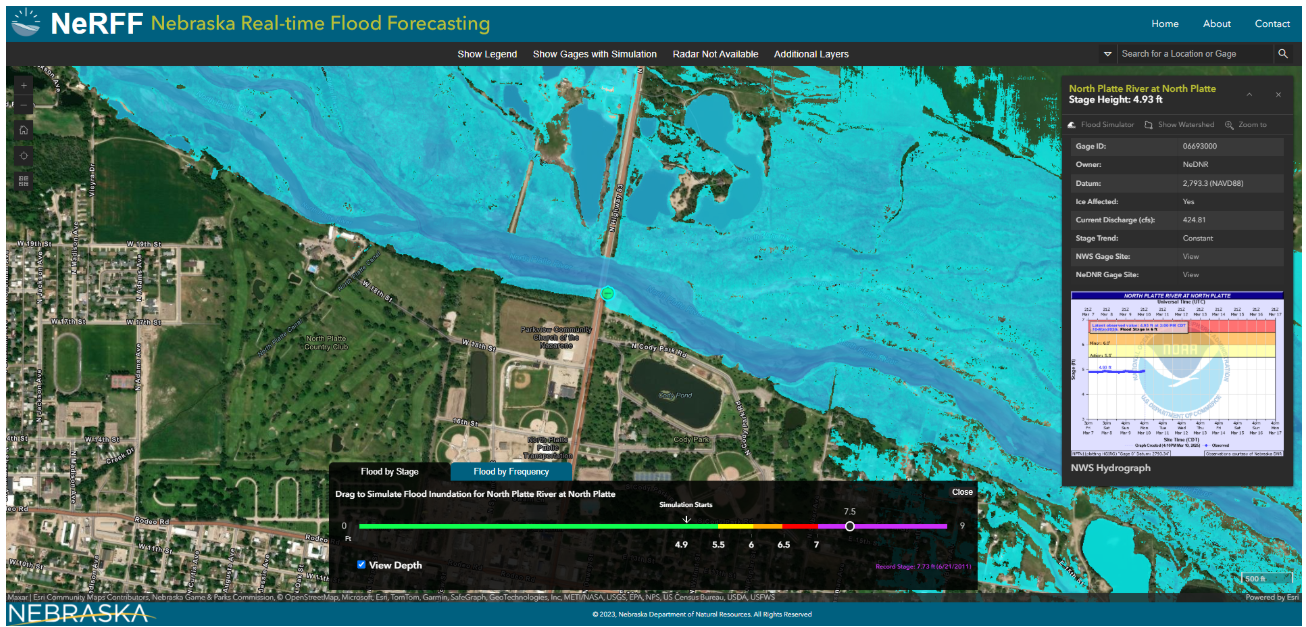What is a floodplain?
A floodplain is an area of low-lying ground adjacent to a river, lake, or ocean which may be subject to flooding during periods of high water. Regulatory floodplains as defined by FEMA are referred to as the 1% Annual Chance Floodplain or 100-year Floodplain.
Is my property in a floodplain?
Visit the Nebraska Floodplain Management Division's Floodplain Interactive Map to locate your property and proximity to a floodplain. You may also contact your local Floodplain Administrator.
My home is in the 1% Annual Chance Floodplain, what is the chance my home will be flooded?
In any given year, your property has at least a 1% chance of being flooded. During the course of a 30-year mortgage, your property has at least a 26% chance of being flooded. The actual risk due to flooding varies depending on your location within the floodplain.
Who can buy flood insurance? When is flood insurance mandatory?
For a community participating in the National Flood Insurance Program (NFIP), any property owner is eligible to buy a Flood Insurance policy, regardless of whether the property is in the floodplain. Under federal law, the purchase of flood insurance is mandatory for properties with a federally-backed mortgage that lie within the effective 1% Annual Chance Floodplain.
How can I get flood insurance?
You can learn more about purchasing flood insurance and finding an insurance agent at https://www.floodsmart.gov/. You can also contact any local insurance agent to ask about flood insurance.
What can I do if my lender has determined that my structure is in the floodplain but I believe it is out?
In situations where a property owner thinks their property was inadvertently mapped in a floodplain, FEMA provides a process for the public to request a change in the flood zone designation for the property. This request is known as a Letter of Map Change (LOMC). For more information on obtaining a Letter of Map Change, contact your local Floodplain Administrator. To learn more about FEMA’s process, you can check the FEMA webpage on LOMCs.
What will happen if I build a basement in the floodplain?
Basements are often built well below the Base Flood Elevation (BFE) and make a structure very susceptible to flooding. When a basement is flooded, the foundation walls that hold the entire structure can collapse and cause the entire structure to be damaged. Nebraska state statutes require new structures to have the lowest floor of the basement elevated at least one foot above the Base Flood Elevation. In most communities that have a floodplain management ordinance, putting in a basement without complying with this standard is illegal. Additionally, flood insurance premiums for new residential structures with basements below BFE will be very high. For non-residential buildings, you may dry-proof a basement (including utilities) to at least one foot above the base flood elevation. The flood proofing methods must be certified by a registered professional engineer or architect.
My house is in the floodway, what can I do?
Nebraska state statutes prohibit any new residential structures from being built in a floodway. Floodways are very dangerous places to live and pose threats to lives, safety, and buildings. Local officials will deny a permit to build a new house in the floodway. If your house is already in the floodway and becomes substantially damaged or if you want to substantially improve your house, the entire house needs to be brought into compliance with your local floodplain ordinance. Depending on the circumstances, the residence may not be allowed to be rebuilt on the current site. If you find yourself in this situation, it is best to check with the local Floodplain Administrator to ensure you have all necessary information on what could be allowed.
I need a floodplain development permit, who do I contact?
To obtain a floodplain development permit, please contact your local Floodplain Administrator.
Do I need an Elevation Certificate? How do I get an Elevation Certificate?
If you want to have your building insurance rated with elevation or removed out of a floodplain with a Letter of Map Change (LOMC), an elevation certificate may assist you in the process. If you are constructing a new building and obtaining a floodplain development permit, you will also need an Elevation Certificate in order to comply with the permit conditions. Elevation Certificates must be prepared and certified by a Licensed Land Surveyor, Registered Professional Engineer, or Registered Professional Architect who is authorized by State, or local law to certify elevation information. Community officials who are authorized by local law or ordinance to provide floodplain management information may also sign the certificate.
How do I obtain a Base Flood Elevation (BFE) Determination for my property?
For basic study areas (Zone A), you can contact U.S. Army Corps of Engineers, FEMA, or any registered professional engineer to make a BFE Determination for your property. The Ebraska Floodplain Management Division can provide BFE Determinations to a local Floodplain Administrator for administrating floodplain management programs in areas with basic flood studies. In areas with Enhanced flood studies, BFE information is published in the Flood Insurance Study (FIS) and the Flood Insurance Rate Map (FIRM). The FIS and FIRM are free to download from FEMA’s Map Service Center.
I live in a floodplain and can’t have a basement, so how do I protect myself from tornados?
You are safest from tornados in a structurally-reinforced room designed to withstand high wind speeds, even if it is not below ground. You can build a safe room inside your house or ask your community to build a community safe room. Federal assistance may be available in such cases. For more information on residential safe rooms, see the FEMA website on Building a Safe Room for Your Home or Small Business.
What additional flood information can I view to better prepare for flooding events?
Visit https://nerff.nebraska.gov/index.html to view Nebraska’s real-time flood conditions, forecasted flood stages at stream gages, and inundation boundaries for nearly 50 communities. The map provides additional flood hazard information in addition to a community’s regulatory floodplain maps. The Nebraska Floodplain Management Division will continue to improve, add data to, and update the map over time. While the map is not intended to be used for the issuance of Floodplain Development Permitting, Insurance Rating, or obtaining Letters of Map Change, it can be used to make informed decisions prior to and during flood events.










